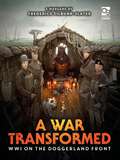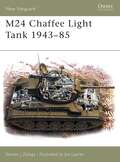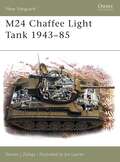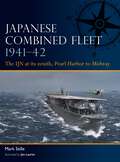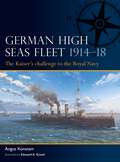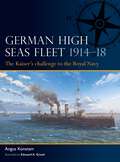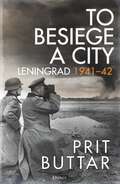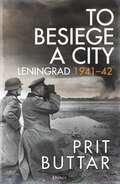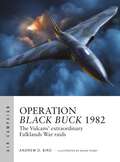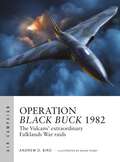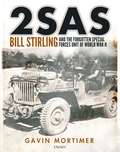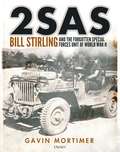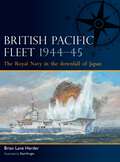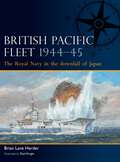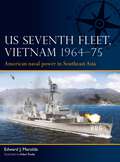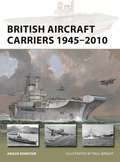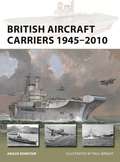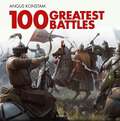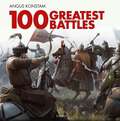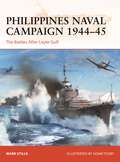- Table View
- List View
A War Transformed: WWI on the Doggerland Front: A Wargame
by Frederick Silburn-SlaterThe Great War meets the horrors of forgotten folklore in this occult skirmish wargame.1916: A World Transformed. As the Great War raged, the Moon fell from its orbit. Seas shifted, uncovering new lands and revealing what tide and time had concealed. Long known as a potent occult power, the Moon's descent also heralded the terrifying resurgence of magic. Long-forgotten gods and spirits began to stir in hidden groves and caverns and old traditions found new strength. Soon, stone circles echoed once more with the chanting of ancient rituals and menhirs were again bedecked with wildflowers and presented with offerings of honey and blood. 1918: A War Transformed. Rival nations battle on new fronts, seeking dominance with weapons of spell, song, and sacrifice. Thrust to the surface, Doggerland, the ancient bridge between Britain and Europe, becomes a crucial battleground in the conflict. In this alien landscape, raiding parties pick through the ribs of wrecks and the ruins of lost villages, war machines festooned with totems and fetishes roll over the brittle bones of long-dead giants, and cavalry charge across plains made verdant by the vegetation returning to this new land with unnatural speed.A War Transformed is a skirmish wargame set in a world where World War I was utterly changed by forces far beyond human comprehension. Players command small forces of infantry, cavalry, artillery, and other… stranger… troops on the Doggerland Front. Fast-paced gameplay and a tense initiative bidding system are combined with authentic folk traditions and occult philosophies of the era – it is a game of rifle and relic, of bayonet and belief, of machine gun and magic.
A War Transformed: WWI on the Doggerland Front: A Wargame
by Frederick Silburn-SlaterThe Great War meets the horrors of forgotten folklore in this occult skirmish wargame.1916: A World Transformed. As the Great War raged, the Moon fell from its orbit. Seas shifted, uncovering new lands and revealing what tide and time had concealed. Long known as a potent occult power, the Moon's descent also heralded the terrifying resurgence of magic. Long-forgotten gods and spirits began to stir in hidden groves and caverns and old traditions found new strength. Soon, stone circles echoed once more with the chanting of ancient rituals and menhirs were again bedecked with wildflowers and presented with offerings of honey and blood. 1918: A War Transformed. Rival nations battle on new fronts, seeking dominance with weapons of spell, song, and sacrifice. Thrust to the surface, Doggerland, the ancient bridge between Britain and Europe, becomes a crucial battleground in the conflict. In this alien landscape, raiding parties pick through the ribs of wrecks and the ruins of lost villages, war machines festooned with totems and fetishes roll over the brittle bones of long-dead giants, and cavalry charge across plains made verdant by the vegetation returning to this new land with unnatural speed.A War Transformed is a skirmish wargame set in a world where World War I was utterly changed by forces far beyond human comprehension. Players command small forces of infantry, cavalry, artillery, and other… stranger… troops on the Doggerland Front. Fast-paced gameplay and a tense initiative bidding system are combined with authentic folk traditions and occult philosophies of the era – it is a game of rifle and relic, of bayonet and belief, of machine gun and magic.
M24 Chaffee Light Tank 1943–85 (New Vanguard)
by Steven J. ZalogaThe history of US light tanks during World War II is a chequered one. The Light Battalions of US Armored Divisions were initially filled with M3A1 and M5 Stuart tanks, however, on the battlefields of North Africa it was realised that these were disastrously under armoured and gunned, and a replacement, or the abandonment of light tank doctrine, was desperately needed. It wasn't until the last few months of WWII that the M24 Chaffee came into service and it was extensively used in combat from the Battle of the Bulge to the final campaigns in Germany. This book will trace the history of this design, its combat record in World War II, its many variants, and its extensive combat record post 1945.
M24 Chaffee Light Tank 1943–85 (New Vanguard)
by Steven J. ZalogaThe history of US light tanks during World War II is a chequered one. The Light Battalions of US Armored Divisions were initially filled with M3A1 and M5 Stuart tanks, however, on the battlefields of North Africa it was realised that these were disastrously under armoured and gunned, and a replacement, or the abandonment of light tank doctrine, was desperately needed. It wasn't until the last few months of WWII that the M24 Chaffee came into service and it was extensively used in combat from the Battle of the Bulge to the final campaigns in Germany. This book will trace the history of this design, its combat record in World War II, its many variants, and its extensive combat record post 1945.
Japanese Combined Fleet 1941–42: The IJN at its zenith, Pearl Harbor to Midway (Fleet #1)
by Mark StilleLaunching Osprey's new Fleet series, this is a spectacularly illustrated, concise and comprehensive account of the Imperial Japanese Navy's striking force at the height of its power.The Imperial Japanese Navy (IJN) entered the Pacific War as one of the most formidable navies in the world, and its combat power was concentrated into one force, the Combined Fleet. In the months that followed Pearl Harbor it enjoyed an unrivaled string of victories, shattering American, British, Australian, and Dutch naval forces. This period of expansion and constant victories ended at the Battle of Midway, after which the Combined Fleet was forced onto the defensive. In this book, Mark Stille draws on his decades of IJN research to explain what made the Combined Fleet the fighting force that it was. Packed with superb original artwork, explanatory 3D diagrams and maps, it examines the fleet's doctrine, innovative tactics and powerful warships. It also details the qualities and importance of IJN leadership, logistics, naval infrastructure, and Japan's shipbuilding capability, and gives an account and analysis of the IJN's combat performance during these crucial months – not just in the famous carrier battles, but also exploring lesser-known elements such as IJN amphibious forces and land-based aviation.
Japanese Combined Fleet 1941–42: The IJN at its zenith, Pearl Harbor to Midway (Fleet #1)
by Mark StilleLaunching Osprey's new Fleet series, this is a spectacularly illustrated, concise and comprehensive account of the Imperial Japanese Navy's striking force at the height of its power.The Imperial Japanese Navy (IJN) entered the Pacific War as one of the most formidable navies in the world, and its combat power was concentrated into one force, the Combined Fleet. In the months that followed Pearl Harbor it enjoyed an unrivaled string of victories, shattering American, British, Australian, and Dutch naval forces. This period of expansion and constant victories ended at the Battle of Midway, after which the Combined Fleet was forced onto the defensive. In this book, Mark Stille draws on his decades of IJN research to explain what made the Combined Fleet the fighting force that it was. Packed with superb original artwork, explanatory 3D diagrams and maps, it examines the fleet's doctrine, innovative tactics and powerful warships. It also details the qualities and importance of IJN leadership, logistics, naval infrastructure, and Japan's shipbuilding capability, and gives an account and analysis of the IJN's combat performance during these crucial months – not just in the famous carrier battles, but also exploring lesser-known elements such as IJN amphibious forces and land-based aviation.
German High Seas Fleet 1914–18: The Kaiser’s challenge to the Royal Navy (Fleet #2)
by Angus KonstamA superbly illustrated new account of how Germany's High Seas Fleet was built, operated and fought, as it challenged the world's most powerful navy in World War I.Seven years before the outbreak of World War I, the Imperial German Navy rebranded its Home Fleet as the Hochseeflotte, or High Seas Fleet. It was a force designed to take on the Royal Navy, then the world's most powerful, and for the next four years the North Sea would be their battleground.Drawing on extensive research, Angus Konstam offers the reader a concise, fully illustrated account of how the entire High Seas Fleet was designed and built, how it operated, and how it fought. The fleet was a modern, balanced force of dreadnought battleships, battlecruisers, cruisers and torpedo boats, using Zeppelins and U-boats for reconnaissance. The ultimate test between them came in May 1916, when they clashed at Jutland.Packed with spectacular original artwork, maps, 3D diagrams and archive photos, it explains how and why the fleet was built, its role, and how and why it fought as it did. From fighting doctrine and crew training to intelligence, logistics, and gunnery, this book is an essential guide to the Kaiser's audacious bid for naval glory.
German High Seas Fleet 1914–18: The Kaiser’s challenge to the Royal Navy (Fleet #2)
by Angus KonstamA superbly illustrated new account of how Germany's High Seas Fleet was built, operated and fought, as it challenged the world's most powerful navy in World War I.Seven years before the outbreak of World War I, the Imperial German Navy rebranded its Home Fleet as the Hochseeflotte, or High Seas Fleet. It was a force designed to take on the Royal Navy, then the world's most powerful, and for the next four years the North Sea would be their battleground.Drawing on extensive research, Angus Konstam offers the reader a concise, fully illustrated account of how the entire High Seas Fleet was designed and built, how it operated, and how it fought. The fleet was a modern, balanced force of dreadnought battleships, battlecruisers, cruisers and torpedo boats, using Zeppelins and U-boats for reconnaissance. The ultimate test between them came in May 1916, when they clashed at Jutland.Packed with spectacular original artwork, maps, 3D diagrams and archive photos, it explains how and why the fleet was built, its role, and how and why it fought as it did. From fighting doctrine and crew training to intelligence, logistics, and gunnery, this book is an essential guide to the Kaiser's audacious bid for naval glory.
Nautilus to Columbia: 70 years of the US Navy's Nuclear Submarines
by James C. GoodallA highly illustrated history of the US Navy's nuclear submarine program, from the postwar years to the 2020 Columbia-class SSBNs.James C. Goodall covers the origins, design and development of the US Navy's fleet of nuclear-powered submarines. This program was developed under the command of Hiram G. Rickover, the “Father of the Nuclear Navy” who oversaw the commissioning of the very first nuclear-powered attack submarine, the USS Nautilus (SSN 571) in 1952. This was a truly revolutionary design. Until the advent of nuclear power, the world's submarine fleets traveled on the surface at night to charge their batteries, and only dove below the surface when enemy ships or planes were spotted. With the development of the USS Nautilus, the US Navy now had the ability to stay submerged for not just hours or days, but to hide out of harm's way for weeks or months at a timeThis highly illustrated book covers all of the 220+ submarine hulls built and delivered to the US Navy from the USS Nautilus through to the Navy's newest class of submarine, the Columbia class SSBNs. The story of the Nuclear Navy from its origins up to the present day is told through more than 1,300 images from official and archive sources, as well as the author's own personal collection, some of which have never been published before.
Nautilus to Columbia: 70 years of the US Navy's Nuclear Submarines
by James C. GoodallA highly illustrated history of the US Navy's nuclear submarine program, from the postwar years to the 2020 Columbia-class SSBNs.James C. Goodall covers the origins, design and development of the US Navy's fleet of nuclear-powered submarines. This program was developed under the command of Hiram G. Rickover, the “Father of the Nuclear Navy” who oversaw the commissioning of the very first nuclear-powered attack submarine, the USS Nautilus (SSN 571) in 1952. This was a truly revolutionary design. Until the advent of nuclear power, the world's submarine fleets traveled on the surface at night to charge their batteries, and only dove below the surface when enemy ships or planes were spotted. With the development of the USS Nautilus, the US Navy now had the ability to stay submerged for not just hours or days, but to hide out of harm's way for weeks or months at a timeThis highly illustrated book covers all of the 220+ submarine hulls built and delivered to the US Navy from the USS Nautilus through to the Navy's newest class of submarine, the Columbia class SSBNs. The story of the Nuclear Navy from its origins up to the present day is told through more than 1,300 images from official and archive sources, as well as the author's own personal collection, some of which have never been published before.
To Besiege a City: Leningrad 1941–42
by Prit ButtarA ground-breaking history of one of the greatest ever sieges. Masterfully brought to life by a leading expert using original Russian and German source material.'[An] excellent account.' - Richard Overy, The Telegraph This new history of the first two years of this crucial battle for the heart and soul of Russia is the first in over a decade and also the first to look comprehensively at the wider military strategies of both sides. At a huge cost, the Red Army and the civilian population of Leningrad ultimately endured a bitter 900-day siege, struggling against constant bombing, shelling, and starvation. Throughout the siege, Soviet forces tried to break the German lines and restore contact with the garrison. To Besiege a City charts the first of these offensives which began in January 1942 and was followed by repeated assaults. Acclaimed Eastern Front historian Prit Buttar details how although the Red Army suffered huge casualties in the swampy and forested terrain, the German infantry divisions were also steadily eroded. Indeed, by keeping control of parts of the shores of Lake Ladoga, the Soviet Union was able to sustain Leningrad through the winters of the siege via the 'road of life', constructed across the frozen lake. This epic history details the dramatic race to create the road across the ice and first-hand accounts from both Soviet and German soldiers, many never previously translated, bring the horrific series of battles and assaults to life. Ultimately the determination of the defenders to hold out during this first phase of the siege and the desperate attempts to break it became a hugely significant part of Russian wartime history. The echoes of the battle persist to this day helping to define both a country and its politics. There is no better time to fully understand this history and To Besiege a City is the most comprehensive account to date.
To Besiege a City: Leningrad 1941–42
by Prit ButtarA ground-breaking history of one of the greatest ever sieges. Masterfully brought to life by a leading expert using original Russian and German source material.'[An] excellent account.' - Richard Overy, The Telegraph This new history of the first two years of this crucial battle for the heart and soul of Russia is the first in over a decade and also the first to look comprehensively at the wider military strategies of both sides. At a huge cost, the Red Army and the civilian population of Leningrad ultimately endured a bitter 900-day siege, struggling against constant bombing, shelling, and starvation. Throughout the siege, Soviet forces tried to break the German lines and restore contact with the garrison. To Besiege a City charts the first of these offensives which began in January 1942 and was followed by repeated assaults. Acclaimed Eastern Front historian Prit Buttar details how although the Red Army suffered huge casualties in the swampy and forested terrain, the German infantry divisions were also steadily eroded. Indeed, by keeping control of parts of the shores of Lake Ladoga, the Soviet Union was able to sustain Leningrad through the winters of the siege via the 'road of life', constructed across the frozen lake. This epic history details the dramatic race to create the road across the ice and first-hand accounts from both Soviet and German soldiers, many never previously translated, bring the horrific series of battles and assaults to life. Ultimately the determination of the defenders to hold out during this first phase of the siege and the desperate attempts to break it became a hugely significant part of Russian wartime history. The echoes of the battle persist to this day helping to define both a country and its politics. There is no better time to fully understand this history and To Besiege a City is the most comprehensive account to date.
Operation Black Buck 1982: The Vulcans' extraordinary Falklands War raids (Air Campaign #37)
by Andrew Bird'The definitive account of the Vulcan raids… taught me something new on every page'- Rowland White, author of the bestselling Vulcan 607A newly researched, fully illustrated account of how RAF Vulcan bombers flew a series of the world's longest air raids in 1982 against Port Stanley airfield, in a daring, hastily improvised strike against the Argentinian invaders. The RAF's opening shots of the Falklands War were among the most remarkable airstrikes in history. The idea was simple: to destroy the runway at Port Stanley, and prevent Argentinian fast jets using it against the Royal Navy task force. But the nearest British-owned airfield was Ascension Island - 3,900 miles away from the Falklands.Researcher and historian Andrew D. Bird has uncovered new detail of what really made these extraordinary raids possible, including never-before-published information and photos demonstrating the discreet support provided by the United States. Packed with spectacular original artwork and rare photos, this book explains how these hugely complex, yet completely improvised raids were launched. This is also the story of how the last of the Vulcans, only a few months away from the scrapyard, had to be hastily re-equipped to carry conventional bombs, with bombsights, electronics and navigation systems 'borrowed' from other aircraft. Yet they managed to fly what were the longest-range air attacks in history, and struck a severe blow to the occupying Argentinians.
Operation Black Buck 1982: The Vulcans' extraordinary Falklands War raids (Air Campaign #37)
by Andrew Bird'The definitive account of the Vulcan raids… taught me something new on every page'- Rowland White, author of the bestselling Vulcan 607A newly researched, fully illustrated account of how RAF Vulcan bombers flew a series of the world's longest air raids in 1982 against Port Stanley airfield, in a daring, hastily improvised strike against the Argentinian invaders. The RAF's opening shots of the Falklands War were among the most remarkable airstrikes in history. The idea was simple: to destroy the runway at Port Stanley, and prevent Argentinian fast jets using it against the Royal Navy task force. But the nearest British-owned airfield was Ascension Island - 3,900 miles away from the Falklands.Researcher and historian Andrew D. Bird has uncovered new detail of what really made these extraordinary raids possible, including never-before-published information and photos demonstrating the discreet support provided by the United States. Packed with spectacular original artwork and rare photos, this book explains how these hugely complex, yet completely improvised raids were launched. This is also the story of how the last of the Vulcans, only a few months away from the scrapyard, had to be hastily re-equipped to carry conventional bombs, with bombsights, electronics and navigation systems 'borrowed' from other aircraft. Yet they managed to fly what were the longest-range air attacks in history, and struck a severe blow to the occupying Argentinians.
2SAS: Bill Stirling and the forgotten special forces unit of World War II
by Gavin MortimerDrawing on recently declassified files and interviews with veterans, this is a fascinating history of Bill Stirling and 2SAS – pioneering founders of modern special forces. David Stirling is the name synonymous with the wartime SAS, but the real brains behind the operation was in fact Bill Stirling, David's eldest brother. Bill was described in the SAS War Diary as a 'man from the shadows'; it was an apt description for, unlike his attention seeking brother, Bill shunned the spotlight. Now for the first time the truth – and the triumph – of 2SAS is revealed. Having originally joined the SOE in March 1940, Bill Stirling sailed for Cairo in 1941 and there had the idea for a small special forces unit to be led by his mercurial brother. But despite some success, David allowed the legendary 1SAS to drift under his leadership. Following his capture, Bill re-directed 2SAS, under his personal command, to the strategy he had originally envisaged: parachuting behind enemy lines to gather intelligence. Fully illustrated with rare and previously unpublished photographs, this compelling history details how 2SAS fought with ingenuity and aggression, from Italy and then into France before heading through Holland into Germany. The unit was capable of attacking by parachute, jeep or landing craft, establishing a template for future special forces' operations. Their feats have been overshadowed by the many books that have focused on David and 1SAS. 2SAS corrects this oversight, revealing that the real innovator was Bill Stirling – the true pioneer of Who Dares Wins.
2SAS: Bill Stirling and the forgotten special forces unit of World War II
by Gavin MortimerDrawing on recently declassified files and interviews with veterans, this is a fascinating history of Bill Stirling and 2SAS – pioneering founders of modern special forces. David Stirling is the name synonymous with the wartime SAS, but the real brains behind the operation was in fact Bill Stirling, David's eldest brother. Bill was described in the SAS War Diary as a 'man from the shadows'; it was an apt description for, unlike his attention seeking brother, Bill shunned the spotlight. Now for the first time the truth – and the triumph – of 2SAS is revealed. Having originally joined the SOE in March 1940, Bill Stirling sailed for Cairo in 1941 and there had the idea for a small special forces unit to be led by his mercurial brother. But despite some success, David allowed the legendary 1SAS to drift under his leadership. Following his capture, Bill re-directed 2SAS, under his personal command, to the strategy he had originally envisaged: parachuting behind enemy lines to gather intelligence. Fully illustrated with rare and previously unpublished photographs, this compelling history details how 2SAS fought with ingenuity and aggression, from Italy and then into France before heading through Holland into Germany. The unit was capable of attacking by parachute, jeep or landing craft, establishing a template for future special forces' operations. Their feats have been overshadowed by the many books that have focused on David and 1SAS. 2SAS corrects this oversight, revealing that the real innovator was Bill Stirling – the true pioneer of Who Dares Wins.
British Pacific Fleet 1944–45: The Royal Navy in the downfall of Japan (Fleet #3)
by Brian Lane HerderAn illustration-packed new account of the powerful Royal Navy fleet that fought alongside the US Navy throughout the last year of the Pacific War.The British Pacific Fleet was the Royal Navy's primary contribution to the direct defeat of Japan in 1945, and is among the most powerful fleets Britain has ever sent into action. With naval supremacy in home waters achieved by 1944, many of the best and most modern ships in the Royal Navy could be sent to the Pacific, including battleships, submarines, light forces, replenishment groups, and shore establishment. However, the main striking force was the fast carrier force.Illustrated throughout with dramatic new artwork, 3D diagrams, maps and archive photos, this book explains how the Royal Navy joined the Pacific carrier war, and how the fleet adopted the US Navy's ruthlessly effective fast carrier doctrine. With ships optimized for short-range operations in the Atlantic and Mediterranean, the BPF had to rapidly adapt to the long-range, high-tempo warfare of the Pacific, and the story is often one of inspired improvisation. The BPF shared the US Navy's terrifying experience of kamikaze strikes, and famously its armoured carriers proved tougher than the US counterparts. With discussion of the ships, their technology, how the fleet was organized and commanded, and how it fought the campaign, this book is a fascinating exploration of the Royal Navy's part in the victory over Japan.
British Pacific Fleet 1944–45: The Royal Navy in the downfall of Japan (Fleet #3)
by Brian Lane HerderAn illustration-packed new account of the powerful Royal Navy fleet that fought alongside the US Navy throughout the last year of the Pacific War.The British Pacific Fleet was the Royal Navy's primary contribution to the direct defeat of Japan in 1945, and is among the most powerful fleets Britain has ever sent into action. With naval supremacy in home waters achieved by 1944, many of the best and most modern ships in the Royal Navy could be sent to the Pacific, including battleships, submarines, light forces, replenishment groups, and shore establishment. However, the main striking force was the fast carrier force.Illustrated throughout with dramatic new artwork, 3D diagrams, maps and archive photos, this book explains how the Royal Navy joined the Pacific carrier war, and how the fleet adopted the US Navy's ruthlessly effective fast carrier doctrine. With ships optimized for short-range operations in the Atlantic and Mediterranean, the BPF had to rapidly adapt to the long-range, high-tempo warfare of the Pacific, and the story is often one of inspired improvisation. The BPF shared the US Navy's terrifying experience of kamikaze strikes, and famously its armoured carriers proved tougher than the US counterparts. With discussion of the ships, their technology, how the fleet was organized and commanded, and how it fought the campaign, this book is a fascinating exploration of the Royal Navy's part in the victory over Japan.
US Seventh Fleet, Vietnam 1964–75: American naval power in Southeast Asia (Fleet #4)
by Edward J. Marolda"This is a terrific history of the Seventh Fleet's vital service to the United States in the Vietnam War... remarkably researched and interpreted"- Admiral Jonathan W. Greenert, Chief of Naval Operations, 2011–2015 and Commander Seventh Fleet, 2004–2006"Combines a crisp text by the leading authority on the subject, with well-chosen contemporary photographs, new maps, and excellent art work… an excellent introduction to a complex conflict, and the operational lessons learnt."- Professor Andrew Lambert, Laughton Professor of Naval History, King's College LondonA superbly illustrated examination of how the US Navy's most powerful fleet fought the Vietnam War, covering all of its elements from aircraft carriers and heavy cruisers to minesweepers and oilers.The US Navy's Seventh Fleet was at the forefront of America's campaign in Vietnam for a decade, from the Gulf of Tonkin Incident that began it all to the final evacuation of South Vietnam. Its mission was highly strategic, and while its primary role was to provide carrier-based air power over North Vietnam – from Rolling Thunder through Linebacker – the fleet's operations were complex, sensitive, and varied, and required all the capabilities of the fleet.This book is the first overall examination of how US Navy's most powerful fleet fought and operated in Vietnam. Distilled from thousands of declassified secret documents by renowned US Navy specialist Dr Edward J. Marolda, it offers a unique new portrait of how the Seventh Fleet fought the Vietnam War, from the offensive strike power of naval aviation to the vital role of fleet logistics. As well as the carrier operations, he examines the surface combatant fleet's gunfire support role, and its raids against the North Vietnamese coast. Dr Marolda also looks at amphibious warfare, fleet air defense, search-and-rescue, and mining and interdiction operations. Illustrated throughout with archive photos, 3D diagrams and spectacular new artwork, and informed by never-before-translated official documents, publications, and personal accounts from North Vietnamese, Soviet, and Chinese sources, this is the real story behind the US Navy's Vietnam War.
US Seventh Fleet, Vietnam 1964–75: American naval power in Southeast Asia (Fleet #4)
by Edward J. Marolda"This is a terrific history of the Seventh Fleet's vital service to the United States in the Vietnam War... remarkably researched and interpreted"- Admiral Jonathan W. Greenert, Chief of Naval Operations, 2011–2015 and Commander Seventh Fleet, 2004–2006"Combines a crisp text by the leading authority on the subject, with well-chosen contemporary photographs, new maps, and excellent art work… an excellent introduction to a complex conflict, and the operational lessons learnt."- Professor Andrew Lambert, Laughton Professor of Naval History, King's College LondonA superbly illustrated examination of how the US Navy's most powerful fleet fought the Vietnam War, covering all of its elements from aircraft carriers and heavy cruisers to minesweepers and oilers.The US Navy's Seventh Fleet was at the forefront of America's campaign in Vietnam for a decade, from the Gulf of Tonkin Incident that began it all to the final evacuation of South Vietnam. Its mission was highly strategic, and while its primary role was to provide carrier-based air power over North Vietnam – from Rolling Thunder through Linebacker – the fleet's operations were complex, sensitive, and varied, and required all the capabilities of the fleet.This book is the first overall examination of how US Navy's most powerful fleet fought and operated in Vietnam. Distilled from thousands of declassified secret documents by renowned US Navy specialist Dr Edward J. Marolda, it offers a unique new portrait of how the Seventh Fleet fought the Vietnam War, from the offensive strike power of naval aviation to the vital role of fleet logistics. As well as the carrier operations, he examines the surface combatant fleet's gunfire support role, and its raids against the North Vietnamese coast. Dr Marolda also looks at amphibious warfare, fleet air defense, search-and-rescue, and mining and interdiction operations. Illustrated throughout with archive photos, 3D diagrams and spectacular new artwork, and informed by never-before-translated official documents, publications, and personal accounts from North Vietnamese, Soviet, and Chinese sources, this is the real story behind the US Navy's Vietnam War.
British Aircraft Carriers 1945–2010 (New Vanguard)
by Angus KonstamThe history of the Royal Navy flagships that led the fleet through the Cold War, ensured victory in the Falklands War, and saw action in Iraq and the Balkans.In 1945, at the end of World War II, the Royal Navy's carrier fleet proved essential to the post-war world. Royal Navy carriers fought in the Korean War with the UN fleet, in the debacle at Suez, and in British operations in the last days of Empire, in Malaya, Borneo and Aden. But most famously, they were the key to the Royal Navy's victory in the Falklands campaign, and they went on to fight in the two Iraq wars.Illustrated throughout with new profiles of the key carriers and their development, as well as a cutaway of HMS Victorious and superb new illustrations of the carriers in action, this book explains how the Royal Navy's air power changed throughout the Cold War and beyond. Renowned naval historian Angus Konstam explains how the World War II carriers were rebuilt in a pioneering modernization that allowed them to operate a new generation of naval jets. As carriers became more expensive to operate, the Royal Navy had to scrap its conventional fast jets and introduce a new generation of light carriers designed for the innovative Harrier 'jump jet'. When the Falklands War broke out, it was one of these new carriers and one veteran carrier from World War II that gave the Task Force the fighters it needed to defend itself in hostile waters and retake the islands.Covering a period of dramatic change for the Royal Navy, this book is a history of the Royal Navy's most important ships throughout the Cold War, the retreat from Empire, and the Falklands and Iraq wars, up to the moment Royal Navy fixed-wing air power was temporarily axed in 2010.
British Aircraft Carriers 1945–2010 (New Vanguard)
by Angus KonstamThe history of the Royal Navy flagships that led the fleet through the Cold War, ensured victory in the Falklands War, and saw action in Iraq and the Balkans.In 1945, at the end of World War II, the Royal Navy's carrier fleet proved essential to the post-war world. Royal Navy carriers fought in the Korean War with the UN fleet, in the debacle at Suez, and in British operations in the last days of Empire, in Malaya, Borneo and Aden. But most famously, they were the key to the Royal Navy's victory in the Falklands campaign, and they went on to fight in the two Iraq wars.Illustrated throughout with new profiles of the key carriers and their development, as well as a cutaway of HMS Victorious and superb new illustrations of the carriers in action, this book explains how the Royal Navy's air power changed throughout the Cold War and beyond. Renowned naval historian Angus Konstam explains how the World War II carriers were rebuilt in a pioneering modernization that allowed them to operate a new generation of naval jets. As carriers became more expensive to operate, the Royal Navy had to scrap its conventional fast jets and introduce a new generation of light carriers designed for the innovative Harrier 'jump jet'. When the Falklands War broke out, it was one of these new carriers and one veteran carrier from World War II that gave the Task Force the fighters it needed to defend itself in hostile waters and retake the islands.Covering a period of dramatic change for the Royal Navy, this book is a history of the Royal Navy's most important ships throughout the Cold War, the retreat from Empire, and the Falklands and Iraq wars, up to the moment Royal Navy fixed-wing air power was temporarily axed in 2010.
100 Greatest Battles
by Angus KonstamA highly illustrated introduction to some of the greatest battles in world history, from the iconic encounters of the Ancient World such as Thermopylae and Cannae, through to the major clashes of the 20th century epitomized by Stalingrad and Khe Sanh.This concise study by renowned military historian Angus Konstam examines one hundred of the most famous battles from world history. It includes great naval engagements such as Salamis, Trafalgar, Jutland and Midway; pivotal land battles that decided the fate of nations, such as Hastings, Yorktown, Gettysburg and the Somme; and the impact of the new dimension of aerial warfare in the 20th century at Pearl Harbor, in the Battle of Britain and in the skies over Hiroshima.This highly illustrated book features 100 full-colour battlescene artworks from Osprey's comprehensive archive and is the ideal introduction to the battles that changed the course of history.
100 Greatest Battles
by Angus KonstamA highly illustrated introduction to some of the greatest battles in world history, from the iconic encounters of the Ancient World such as Thermopylae and Cannae, through to the major clashes of the 20th century epitomized by Stalingrad and Khe Sanh.This concise study by renowned military historian Angus Konstam examines one hundred of the most famous battles from world history. It includes great naval engagements such as Salamis, Trafalgar, Jutland and Midway; pivotal land battles that decided the fate of nations, such as Hastings, Yorktown, Gettysburg and the Somme; and the impact of the new dimension of aerial warfare in the 20th century at Pearl Harbor, in the Battle of Britain and in the skies over Hiroshima.This highly illustrated book features 100 full-colour battlescene artworks from Osprey's comprehensive archive and is the ideal introduction to the battles that changed the course of history.
Philippines Naval Campaign 1944–45: The Battles After Leyte Gulf (Campaign #399)
by Mark StilleThe forgotten story of the major naval operations conducted in the Philippines by the US and Japanese navies after Leyte Gulf up to the US invasion of Luzon in January 1945. The events that took place in the aftermath of the Battle of Leyte Gulf in October 1944 are often overlooked by military historians. An impressive array of naval operations continued in the Philippines up to January 1945, which included (on the Japanese side) the largest convoys to a contested island during the war, the first kamikaze campaign, and the second largest Imperial Japanese Navy surface operation during the last nine months of the conflict. On the American side, US forces were involved in efforts to cut off Leyte from enemy reinforcement, a massive amphibious invasion off Luzon, and large-scale operations by the Fast Carrier Task Force (TF 38).Expert naval historian Mark Stille throws new light on this often forgotten phase of the Pacific naval war. Among the actions covered are the battles for Ormoc Bay, the invasion of Mindoro, Japanese kamikaze attacks, and US Third Fleet's rampage through the South China Sea between January 10 and 20, 1945. Superb battlescene artworks bring the war at sea and in the air vividly to life, and maps and diagrams guide readers through a range of actions in clear, step-by-step detail.
